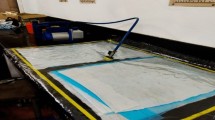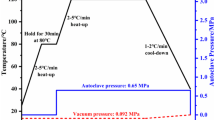Abstract
Glass laminate aluminum reinforced epoxy (GLARE) is a vital class fiber metal laminates (FMLs) and advanced aircraft material. Despite the ongoing research and utilization of FMLs in applications like structures and aircraft, the weakness is particularly the materials’ delamination. This phenomenon is still observed as the primary confinement for an increased and efficient utilization of the materials. In this study, interlaminar shear strength (ILSS) of GLARE composite is improved through many chemical treatments and the anodizing process. T-peel test characterizes the ILSS through the ASTM D1876–08 standard. The numerical model was also developed to predict the ILSS of GLARE laminates and their performance. Results show that the anodizing process enhances the ILSS of GLARE composite. Anodizing makes the aluminium surface porous and improves glass fiber's adhesion with Aluminum surface. The numerical models successfully predict experimental results for un-anodized samples.











Similar content being viewed by others
Change history
18 February 2021
A Correction to this paper has been published: https://doi.org/10.1007/s40799-021-00450-8
References
Marissen, R. (1989). Mechanical aspects related to fibre fracture in ARALL® 2 laminates. In Advances in Fatigue Sci. Technol. (pp. 697–707). Springer, Dordrecht.
Mouritz, A. P., Gellert, E., Burchill, P., & Challis, K. (2001). Review of advanced composite structures for naval ships and submarines. Compos. Struct. 53(1), 21–42.
Al Rashid A, Khan SA, Al-Ghamdi SG, Koç M (2020) Additive manufacturing: Technology, applications, markets, and opportunities for the built environment. Autom Constr 118:103268
Asundi A, Choi AY (1997) Fiber metal laminates: an advanced material for future aircraft. J Mater Process Technol 63(1–3):384–394
Sinmazçelik T, Avcu E, Bora MÖ, Çoban O (2011) A review: Fibre metal laminates, background, bonding types and applied test methods. Mater Des 32(7):3671–3685
Cantwell WJ (2000) The mechanical properties of fibre-metal laminates based on glass fibre reinforced polypropylene. Compos Sci Technol 60(7):1085–1094
Giasin K, Ayvar-Soberanis S, Hodzic A (2015) An experimental study on drilling of unidirectional GLARE fibre metal laminates. Compos Struct 133:794–808
Khalid MY, Nasir MA, Ali A, Al Rashid A, Khan MR (2020) Experimental and numerical characterization of tensile property of jute/carbon fabric reinforced epoxy hybrid composites. SN Appl Sci 2(4):1–10
Fedele R, Raka B, Hild F, Roux S (2009) Identification of adhesive properties in GLARE assemblies using digital image correlation. J Mech Phys Solids 57(7):1003–1016
Kotik HG, Ipiña JEP (2017) Short-beam shear fatigue behavior of fiber metal laminate (Glare). Int J Fatigue 95:236–242
Li Q, Batra RC, Graham I, Dillard DA (2019) Examining T-peel specimen bond length effects: Experimental and numerical explorations of transitions to steady-state debonding. Int J Solids Struct 180:72–83
Ali A, Nasir MA, Khalid MY, Nauman S, Shaker K, Khushnood S et al (2019) Experimental and numerical characterization of mechanical properties of carbon/jute fabric reinforced epoxy hybrid composites. J Mech Sci Technol 33(9):4217–4226
Khan F et al (2017) Effect of various surface preparation techniques on the delamination properties of vacuum infused Carbon fiber reinforced aluminum laminates (CARALL). Experiment Numeric Simulat 31(11):5265–5272
Kamocka M, Mania R J (2019, February) Numerical study of axially compressed FML profile including delamination. In: AIP Conference Proceedings (Vol. 2060, No. 1, p. 020003). AIP Publishing LLC
Al Rashid A, Imran R, Khalid MY (2020) Determination of opening stresses for railway steel under low cycle fatigue using digital image correlation. Theor Appl Fract Mech 108:102601
Lopes CS, Remmers JJ, Gürdal Z (2008) Influence of porosity on the interlaminar shear strength of fibre-metal laminates. Key Eng Mater 383:35–52. Trans Tech Publications Ltd
Qaiser H, Umar S, Nasir A, Shah M, Nauman S (2015) Optimization of interlaminar shear strength behavior of anodized and unanodized ARALL composites fabricated through VARTM process. Int J Mater Form 8(3):481–493
Van Rooijen RGJ, Sinke J, Van Der Zwaag S (2005) Improving the adhesion of thin stainless steel sheets for fibre metal laminate (FML) applications. J Adhes Sci Technol 19(16):1387–1396
Kubit A, Trzepieciński T, Krasowski B, Slota J, Spišák E (2020) Strength analysis of a rib-stiffened GLARE-based thin-walled structure. Mater 13(13):2929
de Freitas ST, Banea MD, Budhe S, de Barros S (2017) Interface adhesion assessment of composite-to-metal bonded joints under salt spray conditions using peel tests. Compos Struct 164:68–75
Alderliesten RC (2007) Analytical prediction model for fatigue crack propagation and delamination growth in Glare. Int J Fatigue 29(4):628–646
Alderliesten RC, Homan JJ (2006) Fatigue and damage tolerance issues of Glare in aircraft structures. Int J Fatigue 28(10):1116–1123
Shim DJ, Alderliesten RC, Spearing SM, Burianek DA (2003) Fatigue crack growth prediction in GLARE hybrid laminates. Compos Sci Technol 63(12):1759–1767
Wu G, Yang JM (2005) The mechanical behavior of GLARE laminates for aircraft structures. J Miner Metal Mater 57(1):72–79
Kinsella M, Murray D, Crane D, Mancinelli J, Kranjc M (2001, November) Mechanical properties of polymeric composites reinforced with high strength glass fibers, vol 33. International SAMPE Technical Conference, pp 1644–1657
Yoon S, Jong W, Soap H, Kwon H (2010) Effects of surface pre-treatment and void content on GLARE laminate process characteristics. J Mater Process Tech 210(8):1008–1016
Xu Y, Li H, Shen Y, Liu S, Wang W, Tao J (2016) Improvement of adhesion performance between aluminum alloy sheet and epoxy based on anodizing technique. Int. J. Adhes. Adhes. 70:74–80
Al Rashid A, Khalid MY, Imran R, Ali U, Koc M (2020) Utilization of banana fiber-reinforced hybrid composites in the sports industry. Materials 13(14):3167
Author information
Authors and Affiliations
Corresponding authors
Additional information
Publisher’s Note
Springer Nature remains neutral with regard to jurisdictional claims in published maps and institutional affiliations.
The original article has been updated to correct second author name as A. Al Rashid, to include missing ORCIDs and to include the missing reference citations in the text.
Rights and permissions
About this article
Cite this article
Khalid, M., Al Rashid, A. & Sheikh, M. Effect of Anodizing Process on Inter Laminar Shear Strength of GLARE Composite through T-Peel Test: Experimental and Numerical Approach. Exp Tech 45, 227–235 (2021). https://doi.org/10.1007/s40799-020-00433-1
Received:
Accepted:
Published:
Issue Date:
DOI: https://doi.org/10.1007/s40799-020-00433-1




